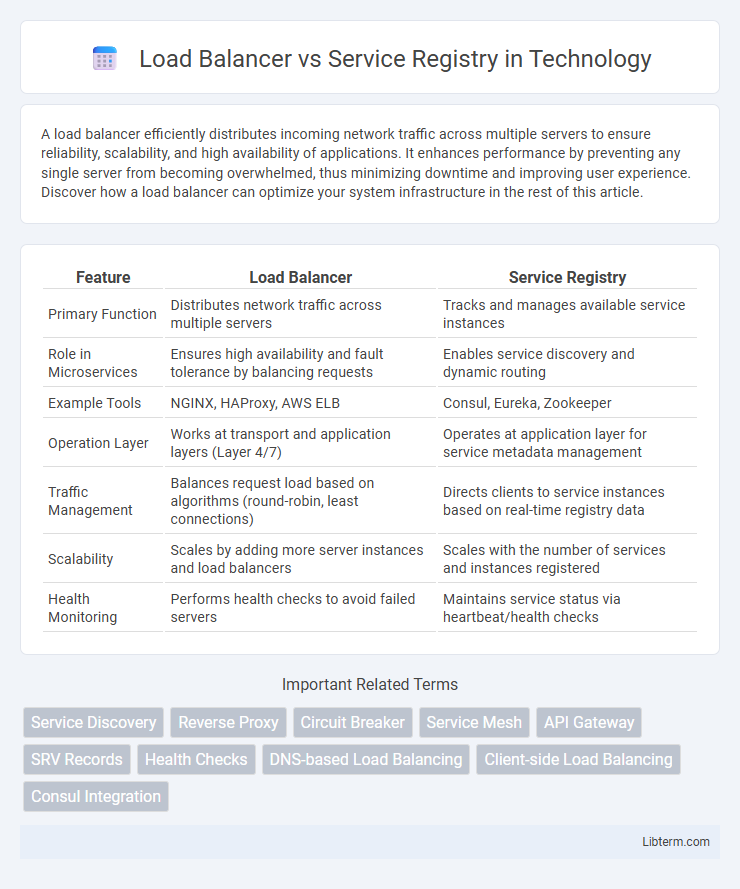A load balancer efficiently distributes incoming network traffic across multiple servers to ensure reliability, scalability, and high availability of applications. It enhances performance by preventing any single server from becoming overwhelmed, thus minimizing downtime and improving user experience. Discover how a load balancer can optimize your system infrastructure in the rest of this article.
Table of Comparison
| Feature | Load Balancer | Service Registry |
|---|---|---|
| Primary Function | Distributes network traffic across multiple servers | Tracks and manages available service instances |
| Role in Microservices | Ensures high availability and fault tolerance by balancing requests | Enables service discovery and dynamic routing |
| Example Tools | NGINX, HAProxy, AWS ELB | Consul, Eureka, Zookeeper |
| Operation Layer | Works at transport and application layers (Layer 4/7) | Operates at application layer for service metadata management |
| Traffic Management | Balances request load based on algorithms (round-robin, least connections) | Directs clients to service instances based on real-time registry data |
| Scalability | Scales by adding more server instances and load balancers | Scales with the number of services and instances registered |
| Health Monitoring | Performs health checks to avoid failed servers | Maintains service status via heartbeat/health checks |
Introduction to Load Balancer and Service Registry
Load balancers distribute incoming network traffic across multiple servers to ensure high availability, reliability, and optimal resource utilization of applications. Service registries maintain a dynamic database of available service instances and their network locations, enabling clients to discover services efficiently in microservices architecture. Combining load balancers with service registries enhances scalability and fault tolerance in distributed systems.
Core Functions of Load Balancers
Load balancers primarily distribute incoming network traffic across multiple servers to ensure high availability and reliability of applications, optimizing resource utilization and minimizing response time. They perform health checks on backend servers to route traffic only to healthy instances, preventing downtime and improving fault tolerance. Load balancers support session persistence, SSL termination, and traffic encryption, enhancing security and user experience in distributed systems.
Key Features of Service Registries
Service registries provide a dynamic directory of service instances, enabling automatic discovery and health monitoring for microservices architecture. They support real-time updates, ensuring traffic routing to available and healthy services without manual intervention. Unlike load balancers, which primarily distribute network traffic, service registries optimize service discovery and resilience in distributed systems.
How Load Balancers Work
Load balancers distribute incoming network traffic across multiple servers to ensure high availability and reliability of applications by preventing any single server from becoming a bottleneck. They monitor server health by continuously checking the status of each backend instance and automatically reroute traffic away from unhealthy servers to maintain seamless service delivery. By managing session persistence, load balancers optimize user experience and efficiently balance workloads based on algorithms such as round-robin, least connections, or IP hash.
How Service Registries Operate
Service registries operate by maintaining a dynamic database of service instances and their network locations, enabling real-time service discovery within distributed systems. They continuously register, update, and deregister services through health checks and heartbeat mechanisms to ensure accurate routing information. This enables clients and load balancers to query the registry for available services, facilitating efficient request distribution and fault tolerance.
Use Cases: Load Balancer vs Service Registry
Load Balancers efficiently distribute incoming network traffic across multiple servers, improving application availability and fault tolerance, making them ideal for managing high traffic loads and ensuring consistent response times. Service Registries maintain a dynamic list of service instances, enabling automatic service discovery and seamless communication in microservices architectures, crucial for scaling, versioning, and service-oriented deployments. Load Balancers suit scenarios requiring traffic distribution at the network level, while Service Registries excel in environments needing dynamic service discovery and orchestration.
Performance and Scalability Comparison
Load balancers enhance performance by distributing network traffic evenly across multiple servers, reducing response time and preventing server overload, which directly supports high scalability for growing applications. Service registries optimize service discovery by maintaining an updated list of available services, enabling dynamic scaling and efficient routing, but they rely on external load balancing mechanisms for traffic distribution. Combining a load balancer with a service registry achieves superior scalability and performance by ensuring balanced workload distribution alongside real-time service availability management.
Security Considerations
Load balancers enhance security by distributing traffic across multiple servers, reducing the risk of DDoS attacks and providing SSL termination for encrypted connections. Service registries improve authentication and authorization by maintaining an updated directory of microservices, enabling secure service discovery through mutual TLS and access control policies. Combining load balancers with service registries ensures robust protection against unauthorized access and enhances traffic encryption in microservices architectures.
Integration with Microservices Architecture
Load balancers efficiently distribute incoming network traffic across multiple microservice instances, enhancing scalability and fault tolerance within a microservices architecture. Service registries maintain an up-to-date directory of service instances, enabling dynamic discovery and seamless communication between microservices. Integration of load balancers with service registries supports dynamic routing, ensuring requests are directed to healthy and available service instances in real-time.
Choosing the Right Solution for Your Application
Choosing between a load balancer and a service registry depends on your application's architecture and traffic management needs. Load balancers efficiently distribute incoming network traffic across multiple servers to ensure reliability and low latency, ideal for stateless applications and horizontal scaling. Service registries maintain dynamic lists of services and their instances, enabling service discovery in microservices architectures, which is crucial for managing service availability and interaction in complex, distributed systems.
Load Balancer Infographic

 libterm.com
libterm.com